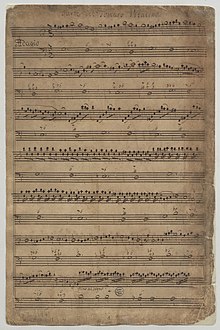| Chaconne in G minor | |
|---|---|
| attributed to Tomaso Antonio Vitali | |
 First page of the Dresden manuscript | |
| Key | G minor |
| Published | 1867 by Ferdinand David |
| Scoring | Violin and continuo |
The Chaconne in G minor is a Baroque composition for violin and continuo, traditionally attributed to the Italian composer Tomaso Antonio Vitali. A Dresden manuscript that may have been transcribed in the early 18th century is the earliest known version of the chaconne, but it was not published until 1867 when Ferdinand David arranged it for violin and piano. The origin of its composition has been debated, with some musicologists hypothesizing that the work is a musical hoax composed by David rather than Vitali. Léopold Charlier made significant alterations to the chaconne in the early 20th century, transforming it into a virtuosic, Romantic-style showpiece. It has been arranged by numerous other composers, including Hans Werner Henze, who used it as the basis for his work Il Vitalino raddoppiato (1977).
Differing somewhat from the major archetypes of ground bass variations, the chaconne features a descending tetrachord in the continuo part, the lowest voice (this bass-line pattern is traditionally associated with lament and figured, at a time, more prominently in the passacaglia), above which the violin part presents increasingly complex variations on the original theme. There are several abrupt changes in the key between variations, atypical of other chaconnes from the Baroque era. Some suggest that this characteristic, along with the observation that the chaconne is dissimilar to Vitali's other surviving compositions, is indicative of a different composer. Jascha Heifetz began his American debut recital at Carnegie Hall in 1917 with the chaconne and regularly performed it as part of his concert repertoire for the next four decades.